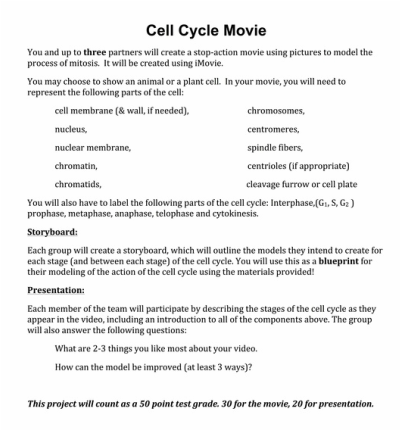|
Valerie Metzler's Inquiry of applied science learning |
Cell Cycle videos

In this series of lessons, students were given the task of creating their own video models of the cell cycle using materials of their choice. Students were given time in class and most students worked in groups of two or three.
Although this project had a relatively prescribed end product in mind, students collaborated to produce a creative video, making decisions about how they would represent the cell and the components involved in cell division. It was exciting to see students constructing their knowledge together as they discussed the phases of the cell cycle and all the steps that needed to be shown in between these phases (Vavra et al., 2011). In the process of learning about cell division, students were also learning to use cameras and create movies on iMovie, which are valuable skills students can use in future projects or personal endeavors.
On the day the projects were due, students played their videos on the projector and explained the phases of the cell cycle and the structures involved in the process to the whole class. This gave students the opportunity to proudly display their work, and also motivated them to have an understanding of the phases shown in their videos so they were not embarrassed in front of the class. It was clear to me that students need more practice presenting to their peers, but this process gave students more experience and confidence in their public speaking abilities. It was also valuable for students to see other presentations in order to gain an understanding that some models look different, but all represent the same process.
Although this project had a relatively prescribed end product in mind, students collaborated to produce a creative video, making decisions about how they would represent the cell and the components involved in cell division. It was exciting to see students constructing their knowledge together as they discussed the phases of the cell cycle and all the steps that needed to be shown in between these phases (Vavra et al., 2011). In the process of learning about cell division, students were also learning to use cameras and create movies on iMovie, which are valuable skills students can use in future projects or personal endeavors.
On the day the projects were due, students played their videos on the projector and explained the phases of the cell cycle and the structures involved in the process to the whole class. This gave students the opportunity to proudly display their work, and also motivated them to have an understanding of the phases shown in their videos so they were not embarrassed in front of the class. It was clear to me that students need more practice presenting to their peers, but this process gave students more experience and confidence in their public speaking abilities. It was also valuable for students to see other presentations in order to gain an understanding that some models look different, but all represent the same process.
|
|
|
Above are three projects submitted by students, modeling the cell cycle. As you are looking at the videos, notice the materials used in the creation of their cell model and the number of frames in each stop-action sequence. The project description is in the bottom left quadrant.

